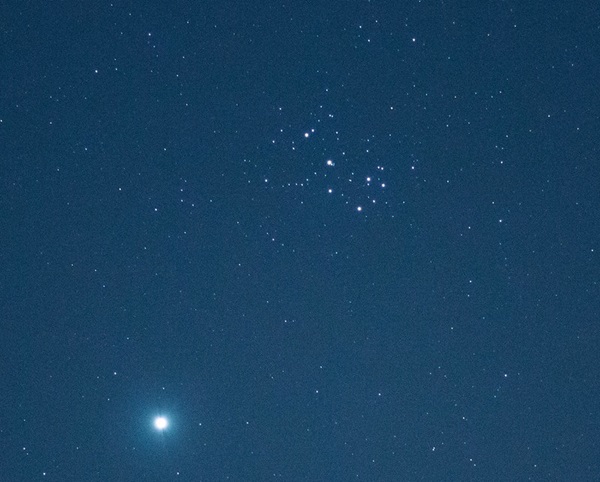The Sky This Week from April 3 to 10 – Astronomy Magazine
Venus visits the Pleiades
This week, the planet Venus slips through the famous Pleiades star cluster. It will come far closer than its April 2015 visit, when this image was taken.
Stephen Rahn (Flickr)
Venus passes through the Seven Sisters’ territory tonight, slipping among the bright Pleiades (M45). This young cluster of stars is more than 400 light-years from Earth and thought to have formed about 100 million years ago. Tonight, magnitude –4.6 Venus will hang just 15′, or half the diameter of the Full Moon, from magnitude 2.9 Alcyone, the grouping’s brightest star. As twilight falls, you’ll easily spot the bright planet nearly 45° above the horizon, glittering just southeast of the cluster’s dipper shape.
Venus will continue to brighten subtly throughout the month. The planet reaches greatest brilliancy on the 27th.
Saturday, April 4
Ambitious observers may be able to spot Uranus shortly after sunset. The distant ice giant currently lies nearly 21 astronomical units (AU) from Earth, or 21 times the average Earth-Sun distance. Step outside with your telescope about half an hour after sunset to find the magnitude 6 world roughly 11° above the western horizon. Uranus sinks about 1° closer to the horizon each day. See how long you can catch it before it gets too low.
Sunday, April 5
The waxing Moon is well on its way to Full in just a few days. Tonight, our satellite sits roughly 19° east of Regulus, Leo the Lion’s brightest star. You’ll find the pair east of Orion the Hunter, who stands upright above the southwestern horizon at 10 P.M. local time. The bright star Procyon, one of two that make up Canis Minor the Little Dog, is roughly halfway between the Hunter and the Lion. To Canis Minor’s north are the magnitude 1 stars Castor and Pollux, which form the two heads of Gemini the Twins.
Monday, April 6
In the two to three hours before sunrise, you’ll spot Jupiter, Saturn, and Mars marching upward in the southeastern sky. These three easy-to-spot planets shine at magnitudes –2.2, 0.7, and 0.7, respectively.
And there’s a bonus for more experienced observers: Just 45′ south of Jupiter is magnitude 14.8 Pluto, out of reach for most visual observers but within the grasp of imagers. Currently about 34 AU from the Sun, Pluto is still slowly approaching its aphelion, the farthest point in its orbit from the Sun, where it will lie nearly 50 AU from our star.






